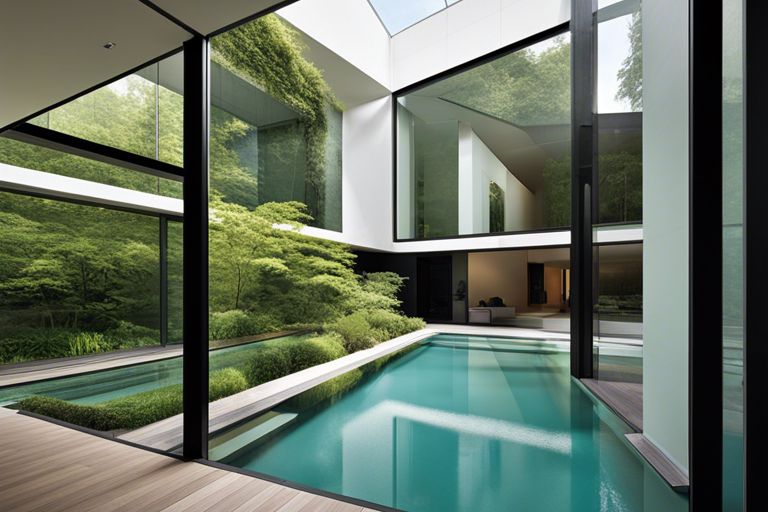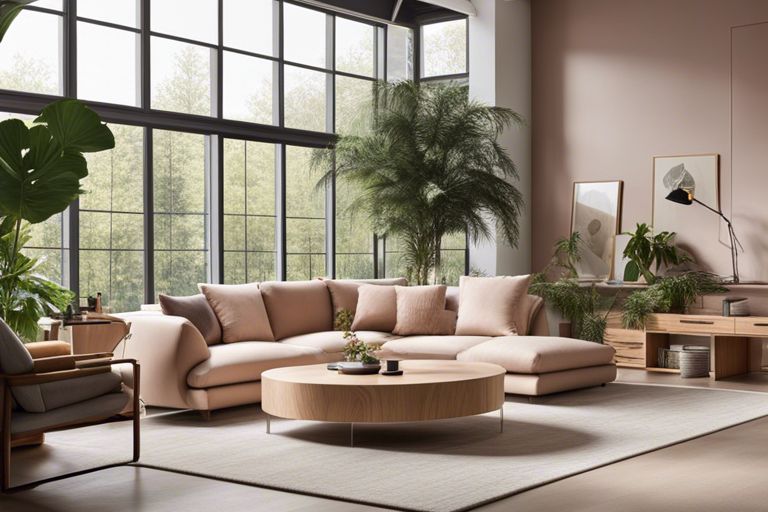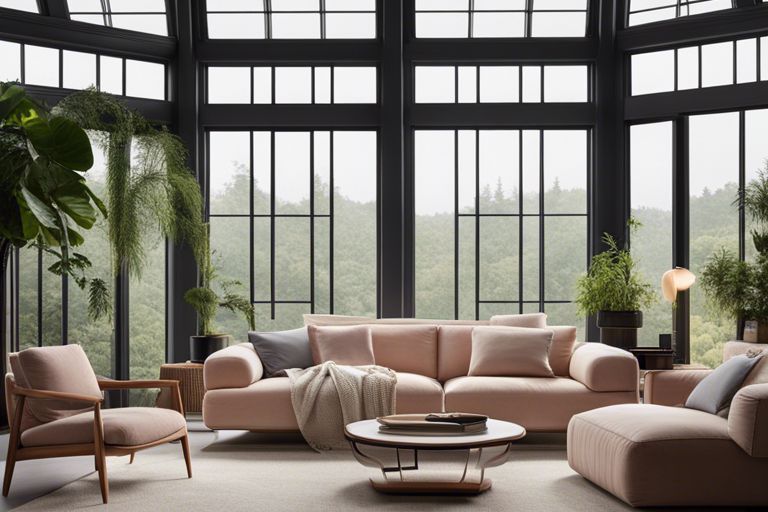It’s time to embrace the beauty and benefits of incorporating nature into your architectural designs. By infusing your spaces with elements of nature, you can create relaxing environments that promote well-being and harmony. Imagine lush green views and tranquil spaces that seamlessly blend with your structures, inspired by the organic designs of Frank Lloyd Wright. Discover how you can bring the outdoors in and enhance your architectural creations with a touch of nature’s serenity.
Key Takeaways:
- Biophilic Design Benefits: Incorporating nature into architecture through features like green roofs, indoor plants, and natural light can improve air quality, reduce stress, and enhance overall well-being.
- Seamless Integration: Architects can create spaces that seamlessly blend with their natural surroundings by using materials like wood and stone, incorporating ample windows for natural light, and designing structures that follow the natural contours of the landscape.
- Sustainable Practices: By embracing biophilic design principles, architects can contribute to sustainable practices by reducing energy consumption, promoting biodiversity, and creating harmonious environments that benefit both people and the planet.
The Importance of Nature in Architecture
While architecture has long been associated with creating structures that serve a functional purpose, it is necessary to recognize the importance of incorporating nature into architectural design. Nature has a profound impact on our well-being and health, and integrating natural elements into our built environment can enhance our overall quality of life. When you consider nature in architecture, you not only create visually appealing spaces, but you also promote a sense of harmony and tranquility that can positively influence your mood and productivity.
Biophilia: The Human Need for Nature
Any architect will tell you that as humans, we have an innate connection to nature known as biophilia. This biophilic inclination means that we are naturally drawn to environments rich in natural elements such as sunlight, greenery, water, and natural materials. When you incorporate biophilic design principles into your architectural projects, you are necessaryly catering to this fundamental human need for nature, resulting in spaces that are not only aesthetically pleasing but also promote well-being and productivity.
The Psychological Benefits of Green Spaces
Human beings have a deep-rooted psychological need to be surrounded by green spaces. Research has shown that exposure to nature in our living and working environments can have a range of positive effects on our mental health and well-being, including reducing stress, increasing creativity, improving concentration, and fostering a sense of peace and relaxation.
Green spaces within architectural designs can serve as retreats from the hustle and bustle of daily life, offering a sanctuary where you can unwind, recharge, and reconnect with the natural world. Whether it’s integrating indoor plants, creating rooftop gardens, or designing courtyard spaces, incorporating green elements into your architectural projects can significantly enhance the overall experience of the space for its occupants.
Design Principles for Incorporating Nature
Orientation and Natural Light
To create a harmonious connection between your architectural design and nature, consider the orientation of your building and how it maximizes natural light. Positioning your structure to take advantage of the sun’s path can help reduce energy consumption by utilizing natural lighting and warmth. By strategically placing windows, skylights, and open spaces, you can invite the outdoors in and create a seamless transition between the interior and exterior of your space.
Ventilation and Air Quality
To ensure a healthy and refreshing environment, incorporate natural ventilation systems into your design. This can include large windows, atriums, and green walls that allow fresh air to circulate throughout the space. Improving air quality through natural ventilation not only enhances the well-being of occupants but also reduces the need for artificial cooling systems, contributing to a more sustainable building.
The relationship between ventilation and air quality is crucial for creating a comfortable and environmentally friendly space. By implementing sustainable practices such as green roofs and living walls, you can further enhance the air quality within your building. These features not only help filter pollutants but also provide insulation, reducing energy consumption and costs in the long run.
Material Selection and Sustainability
An crucial aspect of incorporating nature into architecture is choosing sustainable materials that have minimal impact on the environment. Opt for recycled, renewable, or locally sourced materials to reduce carbon footprint and promote eco-friendly construction practices. Incorporating elements such as wood, bamboo, and recycled steel not only adds a natural aesthetic to your design but also supports a healthy ecosystem.
It is crucial to consider the lifecycle of materials and their environmental impact when selecting building materials. By prioritizing sustainability in your choices, you can create a space that not only connects with nature but also minimizes harm to the planet. Sustainable material selection is a fundamental step towards designing eco-conscious buildings that benefit both occupants and the environment.

Bringing the Outdoors In
Once again, incorporating nature into architecture is a key element in creating harmonious and tranquil spaces. One way to bring the outdoors into your living or working environment is through large windows and skylights, which allow natural light to flood the space and offer views of the surrounding greenery.
Large Windows and Skylights
Windows are not just for ventilation and illumination; they serve as frames for the picturesque scenes of nature outside. By installing large windows and skylights, you can blur the boundaries between the inside and outside, making your space feel more expansive and connected to the environment.
Indoor Gardens and Green Walls
With indoor gardens and green walls, you can create a lush oasis within your built environment. These features not only add visual appeal but also purify the air, reduce stress, and promote a sense of well-being. By incorporating living plants into your design, you can enjoy the calming effects of nature even when indoors.
Indoor gardens and green walls are becoming popular additions to both residential and commercial spaces. You can customize the types of plants and the design of these green features to suit your aesthetic preferences and space constraints.
Natural Materials and Textures
Any architectural design that aims to bring nature indoors should utilize natural materials and textures. Wood, stone, bamboo, and other organic elements not only add a sense of warmth and authenticity to a space but also resonate with the natural world outside. Incorporating these materials can create a sensory experience that engages sight, touch, and even smell, further enhancing your connection to nature.
Gardens integrating natural materials and textures can range from a rustic cabin with exposed wooden beams to a sleek modern office with a stone accent wall. The key is to choose materials that not only look beautiful but also align with your vision of bringing nature into your architectural design.
Creating Tranquil Spaces
Many architectural designs incorporate elements that create tranquil spaces within the structure. These features are meant to provide a sense of calm and relaxation, allowing you to feel more connected to nature even while indoors.
Water Features and Fountains
One way to enhance the tranquility in your architectural design is by incorporating water features and fountains. The soothing sound of water flowing can help create a peaceful atmosphere, making you feel more at ease in your surroundings. Whether it’s a small indoor fountain or a larger outdoor water feature, the sound of trickling water can have a therapeutic effect on your mind and body.
Soundscaping and Acoustics
On the topic of sound, another way to enhance the tranquility of a space is through soundscaping and acoustics. This involves carefully designing the acoustics of a room to create a harmonious sound environment. By minimizing unwanted noise and enhancing natural sounds, such as birds chirping or leaves rustling, you can create a serene atmosphere that promotes relaxation and well-being.
One architectural technique to consider for soundscaping is the use of materials that absorb or diffuse sound, such as cork walls or textured ceiling panels. These materials help reduce echoes and create a more calming auditory experience in your space.
Visual Interest and Focal Points
Focal points and visual interest are necessary in creating tranquil spaces within architecture. By incorporating elements like art installations, sculptures, or unique architectural details, you can draw the eye and create a sense of serenity. Choosing design elements that reflect nature, such as organic shapes or natural materials, can help establish a connection to the outdoors and promote a sense of tranquility within the space.
Creating a focal point in a room can also help anchor the space and provide a visual retreat for the eyes, allowing you to focus and relax in a designated area of the room.
Balancing Nature and Technology
All great architecture finds a balance between nature and technology. In today’s world, this balance is more crucial than ever. Harnessing the power of technology can help you create eco-friendly and sustainable buildings that coexist harmoniously with the natural environment around them.
Energy Efficiency and Renewable Energy
Energy efficiency and renewable energy sources are fundamental elements of sustainable architecture. By incorporating energy-efficient design features such as solar panels, green roofs, and natural ventilation systems, you can reduce your building’s environmental impact and decrease its reliance on non-renewable energy sources. Choosing renewable energy sources like solar or wind power can help you lower your carbon footprint and contribute to a healthier planet.
Smart Home Systems and Automation
Energy Smart home systems and automation technologies can revolutionize the way you interact with your living spaces. By integrating smart technologies like programmable thermostats, lighting controls, and energy monitoring systems, you can optimize your energy usage, increase your comfort, and reduce your utility bills. It’s incredible how these advancements in technology can make your home more sustainable and convenient at the same time.
It Imagine being able to control the lighting, heating, and cooling of your home with a simple touch of a button on your smartphone. With smart home systems and automation, you have the power to create a more energy-efficient and comfortable living environment for you and your family.
Innovative Materials and Building Techniques
Systems
With respect to sustainable architecture, innovative materials and building techniques play a vital role in reducing environmental impact and creating more efficient structures. By utilizing materials like recycled steel, bamboo, or reclaimed wood, you can decrease the demand for new resources and minimize waste generation.
Efficiency These innovative materials not only benefit the environment but also offer unique and visually appealing design possibilities. By exploring new building techniques such as prefabrication or modular construction, you can streamline the building process, reduce construction waste, and create more sustainable structures for future generations to enjoy.
Overcoming Challenges and Constraints
Now, as you probe into incorporating nature into architecture, you may encounter various challenges and constraints along the way. Urban planning and zoning regulations play a significant role in dictating what you can and cannot do with your architectural designs. According to the Architects’ Guide to Biophilic Design: The Benefits of Harmonizing Spaces with Nature, these regulations are in place to ensure that buildings are constructed in a way that is safe and harmonious with the surrounding environment.
Urban Planning and Zoning Regulations
An understanding of these regulations is crucial as they can impact the placement of windows, the amount of green space required, and even the types of materials you can use in your design. Some cities are more open to nature-centric designs, while others may have stricter guidelines that limit your creative freedom. It’s imperative to work closely with local authorities and planners to find a balance between your vision and compliance with these regulations.
Budget and Resource Limitations
One of the most common challenges you may face when incorporating nature into architecture is budget and resource limitations. Creating green spaces, installing energy-efficient systems, and using sustainable materials can add to the overall cost of a project. For instance, incorporating features like green roofs or living walls may require additional structural support and maintenance, which can increase expenses. It’s important to carefully plan and budget for these aspects from the early stages of design to avoid any surprises later on.
One way to address budget constraints is by researching cost-effective alternatives that still allow you to achieve your biophilic design goals. Additionally, you can explore partnerships with local suppliers and contractors who specialize in sustainable practices to help lower costs without compromising on quality.
Climate and Environmental Factors
One of the key considerations when incorporating nature into architecture is the climate and environmental factors of the location where the building will be situated. Weather patterns, temperature fluctuations, and natural light exposure all play a role in determining the success of your design. It’s crucial to study these factors and adapt your architectural plans accordingly to ensure optimal energy efficiency and occupant comfort.
- Proper insulation materials can help regulate indoor temperatures and reduce energy consumption.
- Strategic placement of windows and overhangs can maximize natural light while minimizing heat gain.
- Utilizing passive design strategies like natural ventilation can enhance indoor air quality and reduce the reliance on mechanical systems.
Plus, incorporating features like green roofs and rainwater harvesting systems can help mitigate the building’s impact on the local ecosystem and promote sustainability. Any effort you make to align your design with the natural elements of the site will not only benefit the environment but also enhance the overall well-being of the occupants.
To wrap up
Now that you have learned about the importance of incorporating nature into architecture, you can start thinking about how to bring green views and tranquil spaces into your own designs. By integrating natural elements such as plants, water features, and natural lighting, you can create a harmonious environment that promotes health and well-being. Be mindful of, nature has a way of enhancing our lives and connecting us to the world around us.
Embrace the beauty of nature in your architectural creations and allow it to inspire your designs. Whether it’s through incorporating biophilic design principles, creating green roofs, or designing spaces that blur the line between indoors and outdoors, there are endless possibilities to bring nature into architecture. By doing so, you not only create sustainable and visually appealing spaces but also contribute to a healthier and more harmonious relationship between humans and the natural world.
FAQ
Q: Why is incorporating nature into architecture important?
A: Incorporating nature into architecture is important because it helps create harmonious environments that enhance the well-being of occupants. Nature has a calming effect on people and can improve air quality, reduce stress, and increase overall productivity.
Q: How can architects incorporate nature into their designs?
A: Architects can incorporate nature into their designs in various ways, such as including green roofs, living walls, large windows to provide natural light and views of nature, using natural materials like wood and stone, and creating open spaces that interact seamlessly with the surrounding landscape.
Q: What are the benefits of green views and tranquil spaces in architecture?
A: Green views and tranquil spaces in architecture have numerous benefits, including improved mental and physical health, increased connection to the natural world, energy efficiency through natural ventilation and daylighting, and overall enhancement of the aesthetics and functionality of the built environment.


